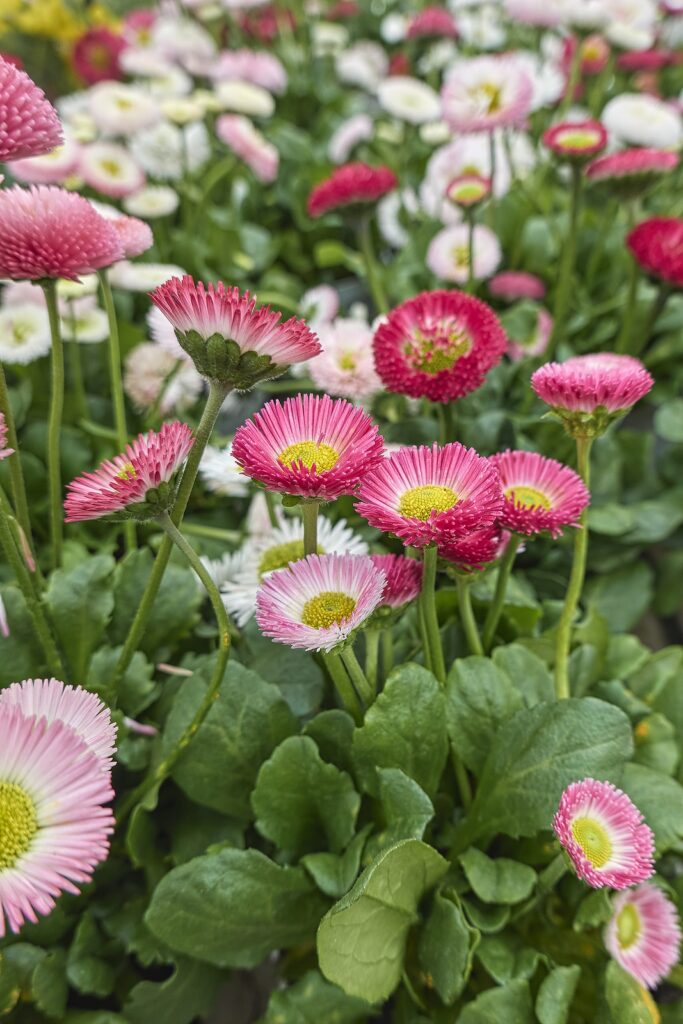English daisy — Bellis perennis—is an easy-to-grow, short-lived perennial commonly grown as a biennial or annual. It bears colorful small daisylike flowers atop rosettes of bright green leaves.
English daisies are members of the Asteraceae family. Plants grow in tufts or with branching stems. The solitary daisy-like heads have yellow disks and white, pink, or red rays. Flower heads are about 2 inches (5cm) across.
English daisies need fertile, moist soil and plenty of sun. They are easily grown from seed in the fall; wintered over in a cold frame, and will flower early the next season. However, they will bloom the first season if the seed is sown very early in the spring.
English daisies can be used for edging and in low beds and borders and for colonizing in lawns. They also grow well in window boxes and other containers.

Get to know Bellis – English daisy
- Plant type: Perennial is often grown as a biennial or annual
- Growing Zones and range: Zones 4 to 7; good winter annual in Zones 8 to 10
- Hardiness: Grows best in cool summer regions, northern, coastal, high-altitude regions; they do not grow well in hot, dry regions
- Height and width: 3 to 8 inches (7.6-20cm) tall, 5 to 9 inches (12-22cm) wide
- Form: Rosettes of oval, green leaves; short, thick stems topped with 1 to 2-inch (2.5-5cm) flowers
- Flowers: Bright daisies are red, pink, and white with yellow centers. Some varieties bear single flowers, while others look more like tiny pompons.
- Bloom time: Early to late spring and through winter in southern regions
- Uses: edging plant and often planted with bulbs
- Garden companions: forget-me-nots, spring-flowering bulbs
- Common name: English daisy
- Botanical name: Bellis perennis
- Family: Asteraceae (Compositae)
Where to plant Bellis – English Daisy
- Plant English daisies in full sun in cool, moist climates. Plant in shade in drier, warmer regions
- Plant English daisies in humus-rich, well-drained soil.
- English daisies prefer a soil pH of 6 to 7.

When to plant Bellis – English daisy
- Set out seedlings in spring or fall in Zones 4-7. In warm regions, Zones 8-10, plant in fall as an annual for spring bloom. English daisies will not do well during the summer in hot regions.
- Sow seed indoors 4 to 8 weeks before the last frost in spring; in mild-winter regions sow seeds in the fall and treat them like biennials.
- Sow seeds in cold frames 2 to 6 weeks before the last frost in spring or sow them in the garden just after the last frost in spring.
Planting and spacing Bellis – English daisy
- Sow seeds 1/8 inch deep, 1 inch (2.5m) apart in flats or six packs.
- Seeds will germinate in 10 to 15 days at about 70°F (21°C).
- English daisies grow quickly; harden off seedlings before planting them outdoors.
- Set established plants in the garden after the last frost in spring. Established plants can be planted at any time during spring and autumn.
- Space English daisy 6 to 8 inches (15-20cm) apart.

How to water and feed Bellis – English daisy
- English daisies need moderate water; keep the soil evenly moist.
- Fertilize English daisies at planting time and lightly throughout the growing season; use an all-purpose fertilizer.
- Feed biennials with a top-dressing of aged compost in autumn.
Bellis – English daisy care
- Remove spent flowers to encourage more blooms.
- Apply a winter mulch in Zone 6 and colder; use sifted aged compost or chopped leaves.
- English daisy is prone to powdery mildew; spray plants with a fungicide if you notice the start of powdery mildew.
- Pull out spent plants and start new ones.
Bellis – English daisy propagation
- Propagate English daisies can be propagated by seed or division.
- Sow seed indoors in midwinter to set plants out in mid-spring. Cover seed lightly.
- Divide crowded clumps in early spring when new growth begins. Replant divisions immediately.
Bellis – English daisy varieties to grow
- Bellis perennis. Wild types have tiny, single flowers–golden discs surrounded by pink or white petals. Cultivars have showy flowers: ‘Button’ series has double red or pink flowers; ‘Kito’ has large semi-quilled cherry red flowers; ‘Monstrosa’ has large flowers nearly 4-inches wide in red, pink, and white; ‘Super Enorma’ series has double 3-inch flowers; ‘Tasso’ series had double red, pink, or white blooms and quilled (pompon) petals.
- Bellis rotundifolia is similar to Bellis perennis but with rounder leaves. B. r. caerulescens is a pretty lavender-blue type from North Africa.















